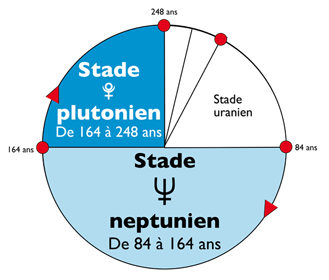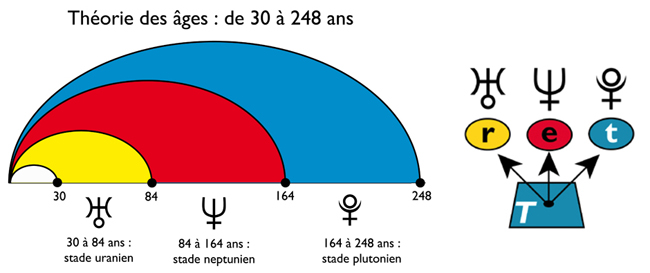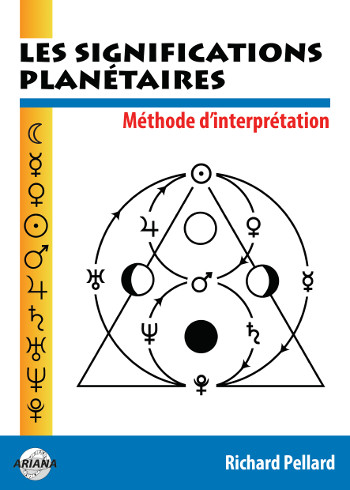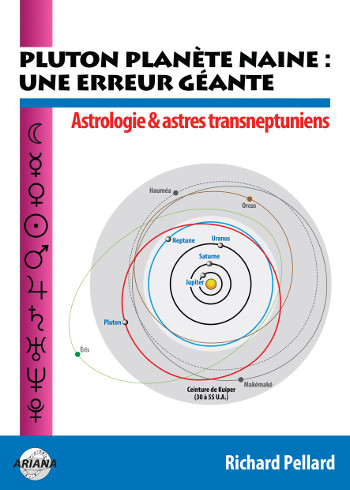Your Planets
Portraits of the Planets
Aspects between Planets
The planetary ages
The planetary families
Planets in Signs
The Planets in comics


With Neptune And Pluto, we are entering the era of very long durations which greatly exceed that of individual life. The revolution time of Uranus (eighty-four years) covers the average human life expectancy. At the end of the first cycle of Uranus, we still have some chance of belonging to the world of the living. This is no longer the case at one hundred and sixty-four years, when Neptune has made a complete revolution around the Sun, and even less so at two hundred and forty-eight years, when the first revolution of Pluto ends. From eighty-four to one hundred and sixty-four years, there is, however, a planetary interval of time: the neptunian stage. According to astrology, man is therefore still evolving, he still has learning to do after his eighty-fourth year.

The maximum duration of human life is currently estimated at around one hundred and thirty years. The individual therefore has no possibility of going to the end of the Neptunian apprenticeships. There neptunian function would therefore concern in humans the probability of partial learning, barely sketched, certain to remain unfinished. During his second centenary, he was given the opportunity to further transform his vision of the world, without being able to go through with this ultimate metamorphosis. Mystery… and even greater mystery as to the contents of the Plutonian stage (from one hundred and sixty-four to two hundred and forty-eight years)! What do we learn or unlearn when we are no longer of this world? Would the very long durations of Neptune and Pluto mean that these planets exert no influence on the individual?

To better understand the stakes of the Neptunian stage and the plutonian stage, it is worth specifying what astrology means when it speaks of“planetary influences”. The meanings attributed to each star have not been distributed at random, according to the fantasy, subjectivity or imagination of astrologers. They flow logically (astro-logically), you have been able to observe and convince yourself of this by reading the previous pages, from the duration of its cycle and from the position it occupies in relation to the other stars in the whole formed by the system. solar. This explains why each age of life corresponds to a planet.

Each age of life therefore sees the emergence of a new “planetary function”, that is to say the appearance of a certain astro-psychological structure which will imprint its characteristic mark in our psychic universe and our nervous system. To understand this concept of “planetary function” and assess its influence on human behavior, we can take the example of a container and what fills it. The vessel is a container, an empty structure. What is inside the container is a content. The container gives the content a certain form, without changing its nature. The specific form that the container gives to the content is not, however, without importance. The container acts on certain properties of the content. Indeed, if we agitate water (the contents) trying to create a whirlwind movement, we do not obtain the same results depending on whether the liquid is in a spherical or cubic container (the container). In the spherical container, the whirlpool is created naturally, fluidly, without splashing. In the cubic container, try to obtain the same result…
The “planetary functions” that appear at each age are empty containers, “receptacles” which will be gradually filled by our experiences and learnings which will constitute the content. Between two and twelve years of age, for example, the child primarily integrates the Jupiterian function. In itself, this “Jupiter function” is an empty container, which nevertheless gives a precise form to everything that he will have to experience during this period. By schematizing, we can say that the function of Jupiter is to insert lived experience into a normative framework. This is true for all children between the ages of two and twelve from all walks of life and from all eras. But the astrological knowledge of this container does not in any way allow us to prejudge the content that the child will give it. The nature of this content will depend on his sex, his hereditary heritage, his social, economic, cultural conditions, the type of education he has received, the norms of the society to which he belongs and those of his parents, etc., and of course his natal horoscope.
We can and must therefore clearly distinguish between the container and the content. The operation “Insert your experience into a normative framework” will not be carried out in the same way depending on whether one is man or woman, rich or poor, black or white, man of the Cro-Magnon or of the post-industrial era, etc. The experience and the rules of social life vary widely according to the environment and the times. But this formal distinction should not make us forget that, in the same way that the spherical or cubic shape of a container determines the possible movements of the liquid it contains, the nature of each of the “planetary containers” influences the type of experiences we will prioritize during a given stage. Let’s take the example of the jupiterian stage from two to twelve years: during this period, the operation “Insert your experience into a normative framework” encourages the child to remember above all, in his general conditions of life, what goes in the direction of this necessary learning. He is extremely attentive to all content that can promote his socialization, and therefore ignores what he has already learned before the age of two and what he still has to learn during the following stages, or does not retain any that the part which he considers may be useful to him for “Insert your experience into a normative framework” between two and twelve years old.
From birth to one hundred and thirty years which constitute for the moment our maximum life expectancy, the baby, the child, the teenager, the adult then the old man can give to the “container” planetary content for each stage according to the specific conditions in which their learning will take place: masculine content for men and feminine for women, poor content for the poor and rich content for the rich, etc. Those who live to be eighty-four can give full content to the “container” uranian, to the uranian function. They will have completed the entirety of that slice of life that took them from adulthood to mature individuals into old age.
From the Moon to Uranus inclusive (from zero to eighty-four years), each function, each planetary container can have a content, different according to each individual. The very long durations of the Neptunian and Plutonian cycles modify this state of affairs: with Neptune and Pluto, there can be containers without content, planetary functions without lived experience, without learning. By dying before eighty-four years, one will never fulfill the Neptunian function of any individual content during the stage it governs (eighty-four to one hundred and sixty-four years). As for the position of the Plutonian stage (from one hundred and sixty-four to two hundred and fifty years) in this series of planetary ages, it obviously excludes any possibility of personal learning based on lived experiences…
And yet, Neptune or Pluto exist. Astrologers take into account their reality and the position they occupy when making a horoscope. Neptune and Pluto can be strong and dominant at birth, which means that there are individuals who more frequently than others have Neptunian or Plutonian behaviors. This is so true that you will find, in the chapter Planetary Profiles, a detailed description of their psychological functioning. The “neptunians” or “plutonians” are not exceptional and do not behave like the living dead or ghosts from beyond the grave, contrary to what their awareness of cycles that exceed the duration of individual existence might lead one to believe. During their lifetime, they even give, like everyone else, an individualized content to their planetary containers. But then, what mysterious content is it?
The influence of each planet is effective from the moment of birth: it is for this reason that it is possible to describe the major tendencies of an individual’s personality by making his astral chart, and it is which justifies, to a very large extent, the psychological differences between people of the same age. The psychological tendencies expressed by a planet are therefore present in the instant photograph of the birth sky represented by the astrological chart. They do not wait, to manifest themselves in the behavior of an individual, for the age when they will fully reveal themselves and integrate.
Before this age, these tendencies appear in the form of more or less successful outlines, of uncertain prefigurations. At the age of eight (Jupiterian stage), a child born under a strong influence of Saturn, for example, will be more and more frequently thoughtful, introverted and isolated than children of the same age in general and especially those born under a strong influence of Jupiter. He will have behaviors that can be described as adolescents earlier than others. When the age of integration of this tendency is over, it continues to manifest itself by fixing, by crystallizing the experiences lived during the stage which it governs.
The birth chart is in a way a “polaroid”. Like an instantaneous photograph, it fixes at a precise moment all the celestial potentials of the individual. These potentials will be released little by little throughout its life, according to a defined timetable which is largely determined by planetary cycles and rhythms: the Polaroid then turns into a film and, from our first breath, we give content to these structures. stars that inhabit us. Most of them (from Moon to Uranus) will give rise to learning on the job. For the others (Neptune, Pluto), we are forced throughout our lives to improvise, to let our imagination run full time. There is a place in the human being where nothing is ever acquired or learned and where nothing will ever be, a domain where, for lack of being able to learn things, one can only unlearn them or imagine what one could learn.
As soon as we are born, we are ready for all learning, but among them there are some that we will never do, for lack of time, favorable circumstances or means. Between birth and eighty-four years, some, too eager to be adults, never really enjoy their childhood. Others, hostages of an endless childhood, will never know how to become truly adults; and finally others perceive themselves from the outset as being, moreover, neither children nor adults, unclassifiable. This is very often the case for those born under a strong influence of Neptune and Pluto. These people try throughout their lives to give a random content, made up of confused aspirations, acts or projects which, even when carried out, always leave an impression of unfinished, to a container of which they know nothing.
The birth sky of an individual therefore also represents the mosaic of all the ages of his life: the newborn potentially contains the child, the adolescent, the adult and the old man of which he is the germ. In this context, Neptune and Pluto fully play their role in the structuring of his personality from the start. And throughout our lives all the ages of our lives coexist permanently within ourselves: the adult is always somewhere the child and the adolescent that he was, but also the old man that he will become. Let’s go further: we also carry within us, from our birth and throughout our earthly existence, the dead that we will be. Time is not only chronological, it does not unfold in a linear way with a beginning, a beginning, an end: each moment contains all the past, the present and the future. It is probably this disturbing but real fact that can explain strange phenomena like the fortune telling : if the future exists in the present, it becomes possible to flush it out at every moment. Moreover, rightly or wrongly, astrologers attribute clairvoyance to Neptune…

Evoking the influence of Neptune and Pluto and the stages that these two planets govern forces, as you have understood, to wonder about the beyond of individual existence. Between the ages of eighty-four and two hundred and forty-nine, no one escapes the ultimate vital and lived experience: that of dying, a transcendent experience, which puts our body in direct communication with the great unknown that we have baptized death. “dead”. The “neptunians” And “plutonians” would they therefore be morbid? No more, and perhaps rather less than the average person. Consciously or unconsciously, they are simply more sensitive than others to what life can have that is ephemeral, transient, provisional, and more reluctant to integrate concrete learning and common certainties. Very early on, they jealously cultivate this part of mystery and the unknown which often makes them unpredictable or incomprehensible.
▶ Uranus-Neptune-Pluto: extensive Transcendence
▶ Neptunian stage (from 84 to 164 years old): the age of depersonalization
▶ Plutonian stage (from 164 to 248 years old): the age of disappearance
▶ L’échéancier planétaire et la Théorie des âges

Les significations planétaires
par
620 pages. Illustrations en couleur.
La décision de ne traiter dans ce livre que des significations planétaires ne repose pas sur une sous-estimation du rôle des Signes du zodiaque et des Maisons. Le traditionnel trio Planètes-Zodiaque-Maisons est en effet l’expression d’une structure qui classe ces trois plans selon leur ordre de préséance et dans ce triptyque hiérarchisé, les Planètes occupent le premier rang.
La première partie de ce livre rassemble donc, sous une forme abondamment illustrée de schémas pédagogiques et tableaux explicatifs, une édition originale revue, augmentée et actualisée des textes consacrés aux significations planétaires telles qu’elles ont été définies par l’astrologie conditionaliste et une présentation détaillée des méthodes de hiérarchisation planétaire et d’interprétation accompagnées de nombreux exemples concrets illustrés par des Thèmes de célébrités.
La deuxième partie est consacrée, d’une part à une présentation critique des fondements traditionnels des significations planétaires, d’autre part à une présentation des rapports entre signaux et symboles, astrologie et psychologie. Enfin, la troisième partie présente brièvement les racines astrométriques des significations planétaires… et propose une voie de sortie de l’astrologie pour accéder à une plus vaste dimension noologique et spirituelle qui la prolonge et la contient.
Téléchargez-le dès maintenant dans notre boutique

Pluton planète naine : une erreur géante
par
117 pages. Illustrations en couleur.
Pluton ne fait plus partie des planètes majeures de notre système solaire : telle est la décision prise par une infime minorité d’astronomes lors de l’Assemblée Générale de l’Union Astronomique Internationale qui s’est tenue à Prague en août 2006. Elle est reléguée au rang de “planète naine”, au même titre que les nombreux astres découverts au-delà de son orbite.
Ce livre récapitule et analyse en détail le pourquoi et le comment de cette incroyable et irrationnelle décision contestée par de très nombreux astronomes de premier plan. Quelles sont les effets de cette “nanification” de Pluton sur son statut astrologique ? Faut-il remettre en question son influence et ses significations astro-psychologiques qui semblaient avérées depuis sa découverte en 1930 ? Les “plutoniens” ont-ils cessé d’exister depuis cette décision charlatanesque ? Ce livre pose également le problème des astres transplutoniens nouvellement découverts. Quel statut astrologique et quelles influences et significations précises leur accorder ?
Enfin, cet ouvrage propose une vision unitaire du système solaire qui démontre, chiffes et arguments rationnels à l’appui, que Pluton en est toujours un élément essentiel, ce qui est loin d’être le cas pour les autres astres au-delà de son orbite. Après avoir lu ce livre, vous saurez quoi répondre à ceux qui pensent avoir trouvé, avec l’exclusion de Pluton du cortège planétaire traditionnel, un nouvel argument contre l’astrologie !
Téléchargez-le dès maintenant dans notre boutique